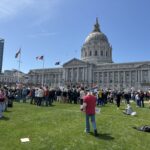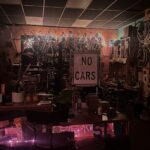Every year in late June, hundreds of thousands of people decked out in rainbow-colored attire flood the streets of San Francisco to celebrate the city’s annual Pride parade. This celebration, a longstanding tradition within the Bay Area, has been marked by a long history of activism and resistance to become the empowering and widespread event that it is today.
At Lick-Wilmerding High School, SF Pride is an event celebrated and attended by many members of the school community. “It’s definitely a fun time and it’s cool to just see how many queer people there are and how big of a thing Pride is,” Chloe Gellerman ’25 said. Analise Chin ’27, who marched in the Pride parade with her middle school, echoed similar sentiments. “Everyone’s just so positive,” she said. “There’s lots of little kids on the sides of the parade that you can go up to…they were so excited. It was very sweet.”
SF Pride first began in 1970 in the aftermath of the Stonewall uprising, a series of riots in 1969 in response to police violence at Stonewall Inn, a gay bar in New York City. Stonewall transformed the gay liberation movement, causing gay rights activism and awareness to explode across the country.
In San Francisco, the first event that resembled the elaborate celebration of today’s Pride consisted of a few hundred marchers walking down Polk Street. But crowd numbers shot up in 1978 when Harvey Milk, a member of the San Francisco Board of Supervisors and the first openly gay elected official in California, spoke at SF Pride. From this point on, San Francisco became an epicenter of LGBTQ+ pride and activism. Today, SF Pride is one of the largest LGBTQ+ celebrations in the world, with the typical number of attendees reaching nearly one million according to the official SF Pride website.

photo courtesy of AP Photo
Even though today SF Pride is considered an event that is inclusive of all identities, it has come a long way from its beginnings, when many members of the LGBTQ+ community were not widely accepted. Despite the transgender community and queer people of color playing a pivotal role in the Stonewall uprising and subsequent queer rights movement, LGBTQ+ spaces have traditionally been reserved for white, cisgender community members. As a result, over the past few decades, the San Francisco queer community has made significant strides towards creating an inclusive environment for all identities.
One example is the San Francisco Trans March that was formed in 2004 with the mission to “create a space for our diverse communities to unite and achieve the social justice and equality that each of us deserves,” according to the Trans March website. Today, the Trans March occurs every Friday before Pride weekend, and is one of the largest trans-led celebrations in the world.
In 2023, SF Pride hired Suzanne Ford as its first transgender Executive Director after she served as Interim Executive Director the year prior. Ford recognizes the significance of this role. “I just want the world to know that a trans woman can be competent and I want the trans community to be proud of me,” she said. “I want [Black and Brown trans people in history] to know that I appreciate that I have this opportunity. It’s because of what they did. And I want to live up to their expectations.”
Black and Brown LGBTQ+ members have also historically been excluded from queer communities, despite the crucial role of People of Color in queer history and activism. In recent years, debate has broken out over whether police officers should be able to march in the Pride parade in their uniforms considering the history of police brutality towards queer people, especially Black and Brown members of the community.
On June 3, 2022, SF Pride and the SF Police Officers Pride Alliance released a joint statement outlining a compromise in which all first responders march together in one contingent, with the majority of them in casual dress. Additionally, the statement announced that the two groups will “host a series of community discussions bringing together the LGBTQ+ community and LGBTQ+ officers.”
Trans and queer POC have also historically not been represented on the SF Pride Board of Directors or in other leadership roles, which Ford acknowledges that the organization has been making efforts to correct. “Over the last three or four years, we have had many more trans people on the [SF Pride] board, and you see way more Black and Brown people on the board,” she said. “For sure the Pride movement as a whole needed to be more inclusive, and you see that Pride reflects the queer community much more now than it did maybe 10 years ago.”
Chin noted that for many underrepresented members of the LGBTQ+ community, SF Pride is a way to reclaim their right to celebrate their identity. “There are definitely groups that march [in Pride] because in the past, they haven’t been able to be so open about their experience,” she said.
For many, SF Pride is more important now than ever due to the significant surge of anti-LGBTQ legislation that has been proposed in recent years, especially bills targeting trans healthcare and rights. According to the Human Rights Campaign, 130 bills targeting transgender rights have already been filed as of January 2024, with 325 anti-LGBTQ+ bills having been proposed overall. This is a considerable increase from 2023, of which 225 anti-trans bills and 503 anti-LGBTQ+ bills were proposed over the course of the entire year.
Kaimana Apana-Chan ’25 expressed the importance of supporting the LGBTQ+ community at this time, especially those in states facing extreme infringements on their rights. “[It’s important to] extend support out to other states who are facing these horrible discrimination bills,” she said. “Especially in the Bay Area, this little chunk of California, we’re kind of in a bubble because for us, everything is fine, but then it’s really not like that for other places.”
Ford also expressed the essentiality of Pride in the midst of the recent uptick in anti-LGBTQ+ legislation. “Queer people are aware that when we wake up every morning we see the anti-LGBTQ legislation, and particularly anti-trans legislation, but we are fiercely fighting,” she said. “But on the other hand, we also want to celebrate our culture and show that we can find joy no matter the outside circumstances within our community.”
Today, SF Pride continues to be a cornerstone of the city’s LGBTQ+ identity, and strives to be an inclusive space for all members of the queer community. “[SF Pride] is part of the city’s identity in a way that you might not get in other places,” Chin said. “I think that’s what makes it really special.”
LWHS community members can support SF Pride in a multitude of ways, including registering at sfpride.org, donating or becoming a member of the event. But according to Ford, the most impactful way to support SF Pride is simply to attend. “The theme this year is called Beacon of Love,” she said. “I want [Pride goers] to know that in San Francisco, you can be who you are and you can love who you love, and we are fierce about that right. We celebrate everyone in our community and what we stand for.”





